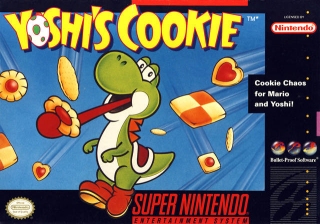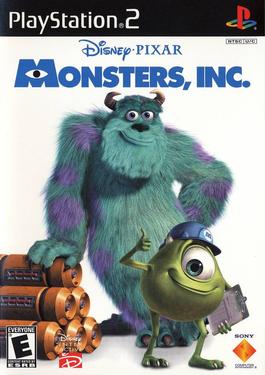
Super Mario World 2: Yoshi's Island is a 1995 platform game developed and published by Nintendo for the Super Nintendo Entertainment System (SNES). The player controls Yoshi, a friendly dinosaur, on a quest to reunite baby Mario with his brother Luigi, who has been kidnapped by Kamek. Yoshi runs and jumps to reach the end of the level while solving puzzles and collecting items with Mario's help.

Yoshi's Cookie is a 1992 tile-matching puzzle video game developed by Tose and published by Nintendo for the NES and Game Boy platforms in 1992. A Super NES version was released the following year, developed and published by Bullet-Proof Software.

Sonic Advance is a 2001 platform video game developed by Sonic Team and Dimps and published by Sega for the Game Boy Advance. It was the first Sonic the Hedgehog game to be released on a Nintendo console with Sonic Adventure 2: Battle on the GameCube, and was produced in commemoration of the series' tenth anniversary. The story follows Sonic, Tails, Knuckles, and Amy as they journey to stop Doctor Eggman from taking over the world. Controlling a character, players are tasked with completing each level, defeating Eggman and his robot army, and collecting the seven Chaos Emeralds.

Kirby Tilt 'n' Tumble is an action puzzle video game developed and published by Nintendo for the Game Boy Color handheld video game console. It was released in Japan on August 23, 2000, and in North America on April 9, 2001. Due to the cartridge having a built-in accelerometer, it has a unique shape, as well as a unique transparent pink color in reference to Kirby. The game received an official re-release on the Nintendo Switch Online service on June 5, 2023.

Star Wars Episode I: Jedi Power Battles is an action Star Wars video game set during the time frame of Star Wars: Episode I – The Phantom Menace. The game was first released for the PlayStation, and afterwards for the Dreamcast and the Game Boy Advance. A remastered version of the game is scheduled to release for Windows, Nintendo Switch, PlayStation 4, PlayStation 5, Xbox One, and Xbox Series X/S in January 2025.

Toki Tori is a puzzle-platform video game developed by Two Tribes and published by Capcom for the Game Boy Color. The game follows a young chick, Toki Tori, and his quest to rescue his younger siblings, still in their eggs. To progress through the game, the player must pick up each egg on a level using a set number of tools, with new tools being introduced as the player progresses through the four worlds. This usually involves careful planning and creative thinking.

Buffy the Vampire Slayer is a 2000 beat 'em up game developed by GameBrains and published by THQ. Based on the television show Buffy the Vampire Slayer, the game features Buffy Summers, who fights vampires, demons, and other supernatural entities as the Slayer. The player controls Buffy through eight side-scrolling levels, and gameplay centers on one-on-one fights with vampires.

Scooby-Doo! Classic Creep Capers is an adventure game published by THQ for the Nintendo 64 and Game Boy Color, based on the Hanna-Barbera cartoon Scooby-Doo, Where Are You!. The Nintendo 64 version, developed by Terraglyph Interactive Studios, was released in November 2000, while the Game Boy Color version was developed by Digital Eclipse Software, and released in February 2001. A PlayStation version, identical to the Nintendo 64 version, had been in development by Terraglyph Interactive Studios but was later cancelled.

Justice League: Injustice for All is a 2002 video game developed by Saffire and published by Midway Games for the Game Boy Advance. The game is based on the Justice League animated television series and showcases the League's seven members within the context of a side-scrolling beat 'em up with platforming elements. The plot centers on the League's efforts to avert global catastrophe carried out by Lex Luthor's Injustice Gang.

Tomb Raider is a 2000 action-adventure video game developed by Core Design and published by THQ for the Game Boy Color under license from series owner Eidos Interactive. Following series protagonist Lara Croft as she searches ruins in South America for a powerful artefact, the gameplay features platforming and puzzle-solving on a 2D side-scrolling environment.

Toy Story 2 is a 1999 side-scrolling platform game for Game Boy Color based on the film of the same name. The game was developed by Tiertex Design Studios and published by THQ. It was released in November 1999 in North America with the European version releasing the following year. The premise of the game loosely follows the original film with players taking control of Buzz Lightyear on a mission to rescue Woody by traversing through stages.

Spider-Man is a 2000 action-adventure game based on the Marvel Comics character of the same name. It was developed by Neversoft and published by Activision for the PlayStation. The game was later ported by different developers to various systems, including the Game Boy Color and Nintendo 64 that same year, the Dreamcast and Microsoft Windows in 2001, and Mac OS in 2002.

Xena: Warrior Princess is a hack and slash video game developed by Universal Studios Digital Arts and co-published by Electronic Arts and Universal Interactive Studios for the PlayStation in 1999. A Game Boy Color version was developed and published by Titus Interactive in 2001. Each version is based on the television series of the same name, which aired from 1995 to 2001.

Monsters, Inc. is a 2001 platform game based on the 2001 film of the same name released for Game Boy Color, Game Boy Advance, and PlayStation 2. The Game Boy Color and Game Boy Advance versions of the game were released in October 26, 2001, in North America and in February 1, 2002, in Europe. The PlayStation 2 version was only released in North America in March 20, 2002. The Game Boy Advance version was also released on a twin pack cartridge bundled with Finding Nemo in 2005.

Planet of the Apes is a 2001 action-adventure video game in the Planet of the Apes franchise. The franchise's first video game, it was released as a tie-in to the 2001 Planet of the Apes film, though the plot is inspired by Pierre Boulle's 1963 novel and the 1968 film adaptation. Fox Interactive contracted Visiware to develop the game for Windows and PlayStation and partnered with Ubi Soft as co-publisher. Torus Games developed a Game Boy Advance and Game Boy Color versions, which are based on the 1968 film and its 1970 sequel.

The Lost Vikings is a 1993 puzzle-platform game developed by Silicon & Synapse and published by Interplay. It was initially released for the Super NES, then subsequently released for the Amiga, Amiga CD32, MS-DOS, and Mega Drive/Genesis. The Mega Drive/Genesis version contains five stages not present in any other version of the game, and can also be played by three players simultaneously. Blizzard re-released the game for the Game Boy Advance in 2003. In 2014, the game was added to Battle.net, emulated through DOSBox. In celebration of the company's 30th anniversary, The Lost Vikings was re-released for Microsoft Windows, Nintendo Switch, PlayStation 4 and Xbox One as part of the Blizzard Arcade Collection in February 2021.

Disney's The Lion King 1½ is a platform game based on the film of the same name, the third and final traditionally-animated film in The Lion King franchise. It was developed by Vicarious Visions and published by Disney Interactive, whilst THQ distributed the game in Europe. The game was released worldwide for Game Boy Advance on October 7, 2003 4 months before the film came out.

Sabre Wulf is a 2004 video game by Rare for the Game Boy Advance. The player controls the safari adventurer Sabreman, who runs and jumps between platforms to retrieve treasure guarded by the Sabre Wulf. The game is a remake of the 1984 action-adventure Sabre Wulf. Though the remake's reviews were generally favourable, sales were lackluster. Reviewers noted the game's simplicity and shallow puzzles. While some found it fun and praised its character animations, reviewers considered its gameplay repetitive.

Dracula: Crazy Vampire is a 2001 action game for the Game Boy Color developed by Planet Interactive Development and published by DreamCatcher Interactive. The game was licensed as part of the Universal Studios Monsters franchise used for Universal Studios books and toys featuring Count Dracula.

Thunderbirds is a 2000 action game for the Game Boy Color developed by Pukka Games and published by SCi Games, licensed from the Thunderbirds franchise, released in 2001 for the Game Boy Advance as Thunderbirds: International Rescue. The game is not to be confused with the 2004 Game Boy Advance title of the same name.




















